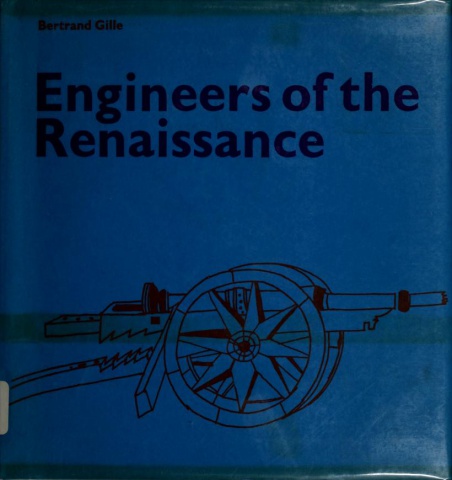Bertrand Gille: Engineers of the Renaissance (1964–) [French, English]
Filed under book | Tags: · art, art history, engineering, history of science, history of technology, machine, mechanics, renaissance, science, technology

“In his reconstruction of Renaissance technology informed by research into little-known manuscripts from libraries across Europe, Bertrand Gille emphasises the close continuity of technical invention from antiquity (in particular, the Alexandrian Greeks), through the mediaeval period (in particular, the Germans), to its brief but brilliant high flaring among the Italians of the fifteenth century. The engineers were conscious of embodying the Archimedean tradition, the tradition of “give me a place to stand and I can move the world.” It was an age marked by a close and natural mutuality between the technical and the fine arts, and by the first real union of science and technology, whose issue was a permanent enrichment of both. Science gave to engineering a new sophistication of mathematical precision, and the working models constructed for mechanical inventions prepared the way for a truly experimental science, as later developed by the generation of Galileo.
As might be expected, the figure of Leonardo da Vinci looms large in this book. It is the author’s contention, based on the documents he has uncovered, that Leonardo’s originality as an engineer has been greatly overestimated, that in fact he borrowed and adapted freely from the work of this anonymous and little-known contemporaries, that many of his ideas are already prefigured in the mediaeval period. Nevertheless, although he rests on the foothills leading up to him, he still towers above them as the consummate technical artist.”
Publisher Hermann, Paris, 1964
239 pages
English edition
Publisher MIT Press, 1966
256 pages
Reviews: Alex Keller (Technology and Culture, 1965), Harry Woolf (Science, 1968), M. Daumas (Revue d’Histoire des sciences et de leurs application, 1964, FR).
Wikipedia (FR)
Les ingénieurs de la Renaissance (French, 1964, 8 MB, added on 2018-12-27)
Engineers of the Renaissance (English, 1966, 8 MB, updated on 2018-12-27)
Stephen Toulmin: Cosmopolis: The Hidden Agenda of Modernity (1990/1992)
Filed under book | Tags: · 1600s, 1700s, 1800s, 1900s, history, humanism, modernity, philosophy, rationalism, renaissance, society

In the seventeenth century, a vision arose which was to captivate the Western imagination for the next three hundred years: the vision of Cosmopolis, a society as rationally ordered as the Newtonian view of nature. While fueling extraordinary advances in all fields of human endeavor, this vision perpetuated a hidden yet persistent agenda: the delusion that human nature and society could be fitted into precise and manageable rational categories. Stephen Toulmin confronts that agenda—its illusions and its consequences for our present and future world.
Originally published by Free Press, New York, a division of Macmillan, 1990
Publisher University of Chicago Press, 1992
ISBN 0226808386, 9780226808383
240 pages
review (Quentin Skinner, The New York Review of Books)
wikipedia
publisher
google books
George Saliba: Islamic Science and the Making of the European Renaissance (2007)
Filed under book | Tags: · astronomy, history of science, islam, renaissance, science

The Islamic scientific tradition has been described many times in accounts of Islamic civilization and general histories of science, with most authors tracing its beginnings to the appropriation of ideas from other ancient civilizations—the Greeks in particular. In this thought-provoking and original book, George Saliba argues that, contrary to the generally accepted view, the foundations of Islamic scientific thought were laid well before Greek sources were formally translated into Arabic in the ninth century. Drawing on an account by the tenth-century intellectual historian Ibn al-Nadīm that is ignored by most modern scholars, Saliba suggests that early translations from mainly Persian and Greek sources outlining elementary scientific ideas for the use of government departments were the impetus for the development of the Islamic scientific tradition. He argues further that there was an organic relationship between the Islamic scientific thought that developed in later centuries and the science that came into being in Europe during the Renaissance.
Saliba outlines the conventional accounts of Islamic science, then discusses their shortcomings and proposes an alternate narrative. Using astronomy as a template for understanding the progress of science in Islamic civilization, Saliba demonstrates the originality of Islamic scientific thought. He details the innovations (including new mathematical tools) made by the Islamic astronomers from the thirteenth to sixteenth centuries, and offers evidence that Copernicus could have known of and drawn on their work. Rather than viewing the rise and fall of Islamic science from the often-narrated perspectives of politics and religion, Saliba focuses on the scientific production itself and the complex social, economic, and intellectual conditions that made it possible.
Publisher MIT Press, 2007
Transformations: Studies in the History of Science and Technology series
ISBN 0262195577, 9780262195577
315 pages
PDF (updated on 2013-6-2)
Comment (0)
